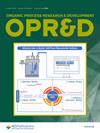Analytical Artifact Due to Residual HCN in Acetonitrile: Identification and Control Strategies
IF 3.1
3区 化学
Q2 CHEMISTRY, APPLIED
引用次数: 0
Abstract
Mismatch in the potency from quantitative 1H NMR (∼96%) and the calculated potency (∼94%) of an aldehyde intermediate led to the investigation of an unknown impurity peak observed in the chromatography. The HR-MS/MS analysis of the unknown impurity suggested it to be the cyanohydrin derivative of the corresponding aldehyde intermediate with the addition of ∼27 amu. Further investigation was performed using analogous 3-methyl iso-nicotinaldehyde as a model compound. A postcolumn hydrogen to deuterium exchange (H/D exchange) experiment further supported the proposed impurity structure as cyanohydrin. The source of HCN for the possible generation of this impurity was traced to certain brands of acetonitrile used duirng the analysis, where the presence of HCN as a contaminant was confirmed and quantified using ion chromatography. The aforementioned model compound was used to investigate the effect of other parameters like diluent composition, sample temperature and storage time, pH of the diluent, and duration of sonication, which impact the formation of such artifact impurity. Based on the results of all the experiments, mitigation strategies were proposed to avoid/control the formation of these impurities during the analytical processing such as use of methanol or HCN-free acetonitrile as a sample diluent, reduced composition of acetonitrile in the diluent, and use of freshly prepared solutions for injections to avoid longer storage time specially when certain sensitive substrates like aldehydes and ketones are analyzed. To evaluate if the formation of this impurity is limited to the compound of interest or if it is a common artifact peak for other similar compounds, various substrates involving aldehyde and ketone functional groups were analyzed under similar analytical conditions. The results indicated that aldehydes were more reactive than ketones, specifically the aldehydes containing a heterocyclic ring such as pyridine were prone to generate the cyanohydrin impurity.

乙腈中残留 HCN 导致的分析误差:识别与控制策略
一种醛中间体的 1H NMR 定量效价(∼96%)与计算效价(∼94%)不匹配,导致对色谱中观察到的未知杂质峰进行了调查。对未知杂质的 HR-MS/MS 分析表明,它是相应醛中间体的氰醇衍生物,添加了 ∼27 amu。以类似的 3-甲基异烟醛为模型化合物进行了进一步研究。柱后氢氘交换(H/D 交换)实验进一步证实了所提出的杂质结构为氰基海德林。可能产生这种杂质的 HCN 的来源被追溯到分析过程中使用的某些品牌的乙腈,使用离子色谱法对 HCN 作为污染物的存在进行了确认和定量。上述模型化合物被用来研究其他参数的影响,如稀释剂成分、样品温度和储存时间、稀释剂的 pH 值和超声处理的持续时间,这些参数都会影响此类人工杂质的形成。根据所有实验的结果,提出了一些缓解策略,以避免/控制分析处理过程中这些杂质的形成,如使用甲醇或不含 HCN 的乙腈作为样品稀释剂,减少稀释剂中乙腈的成分,以及使用新鲜配制的溶液进行进样,以避免较长的储存时间,特别是在分析某些敏感基质(如醛类和酮类)时。为了评估这种杂质的形成是否仅限于相关化合物,还是其他类似化合物的常见伪峰,我们在类似的分析条件下对涉及醛和酮官能团的各种底物进行了分析。结果表明,醛比酮更易发生反应,特别是含有杂环(如吡啶)的醛更易产生氰醇杂质。
本文章由计算机程序翻译,如有差异,请以英文原文为准。
求助全文
约1分钟内获得全文
求助全文
来源期刊
CiteScore
6.90
自引率
14.70%
发文量
251
审稿时长
2 months
期刊介绍:
The journal Organic Process Research & Development serves as a communication tool between industrial chemists and chemists working in universities and research institutes. As such, it reports original work from the broad field of industrial process chemistry but also presents academic results that are relevant, or potentially relevant, to industrial applications. Process chemistry is the science that enables the safe, environmentally benign and ultimately economical manufacturing of organic compounds that are required in larger amounts to help address the needs of society. Consequently, the Journal encompasses every aspect of organic chemistry, including all aspects of catalysis, synthetic methodology development and synthetic strategy exploration, but also includes aspects from analytical and solid-state chemistry and chemical engineering, such as work-up tools,process safety, or flow-chemistry. The goal of development and optimization of chemical reactions and processes is their transfer to a larger scale; original work describing such studies and the actual implementation on scale is highly relevant to the journal. However, studies on new developments from either industry, research institutes or academia that have not yet been demonstrated on scale, but where an industrial utility can be expected and where the study has addressed important prerequisites for a scale-up and has given confidence into the reliability and practicality of the chemistry, also serve the mission of OPR&D as a communication tool between the different contributors to the field.

 求助内容:
求助内容: 应助结果提醒方式:
应助结果提醒方式:


